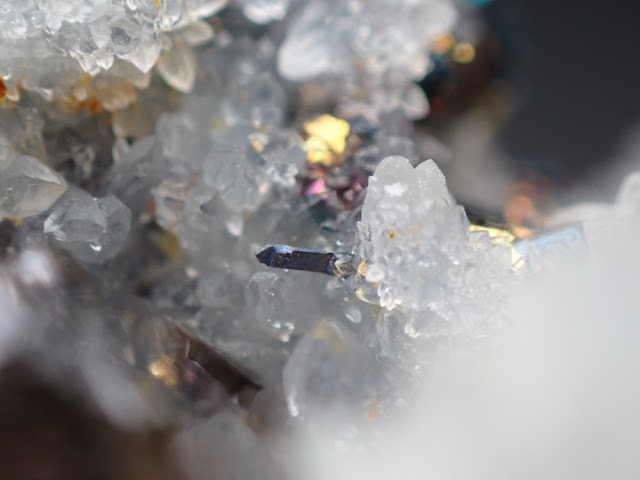ふしぎなやつの正体? A strange shaped crystal
以前、阿仁鉱山産の黄銅鉱、閃亜鉛鉱、石英からなる結晶標本を紹介し、石英に埋まるように長さ 1.5 mm ほどの細長い板状で先端が槍のようにとがっている物体が鎮座していることについて報告した。板の途中にコブがついているのもおもしろい。これがいったい何者なのか、わたしの浅い経験からではその正体を断定することはできないが、いくつか考えられることを以下に記す。
I wrote in a previous post that an elongated platy triangular-head object of 1.5 mm length was embedded in a mineral specimen of chalcopyrite and sphalerite from the Ani mine, Japan. I can't tell what it is, but made some speculations below.
The field of view is 3.7 mm × 5.5 mm.
阿仁鉱 Anilite?
やや青みがかった黒色の感じからすると、これは輝銅鉱(Cu2S)、あるいはその近縁種であるデュルレ鉱(Cu31S16=Cu1.94S)とか方輝銅鉱(Cu9S5=Cu1.8S)かもしれない。こうした鉱物は、東北あたりの銅鉱脈中では、まず鉱液中から黄銅鉱が析出し、その後の酸化作用で輝銅鉱化したものとして産出するのがふつうである。しかし阿仁鉱山では初生鉱物として輝銅鉱がみられ、自形の結晶が観察される場合がある。とくに阿仁鉱(Cu7S4=Cu1.75S)という硫化鉱物がしられており、その名の通り、ここ阿仁鉱山で最初に発見された。
阿仁鉱は産出がレアなので、結晶の形態についてくわしく書かれた資料はなかなか手に入り難い。「鉱物コレクション:コレクターが語る鉱物の魅力」(監修:青木正博、誠文堂新光社、2014年)という本に、光川寛氏所蔵の阿仁鉱の写真が掲載されていて、色合い、結晶の形に類似点がある。氏の標本は「槍型の偏平柱状」で、やはり先端が三角になっている。長さは 7 mm ほどで、おそらく知られている阿仁鉱標本のうちでは最大級のものだ。ただ「偏平」とはいっても、薄板とまでは言えず、酷似しているとはいい難い。
阿仁鉱発見の報告論文には、色は bluish gray(青っぽい灰色)、形は prismatic or platy(柱状もしくは板状)、へき開はなし、とある。また単に「石英脈の晶洞から発見された」とあるだけで、共生鉱物がどうで、鉱化プロセスのどういう段階で生成したか、とかの記述はない。光川氏の標本はむしろ prismatic で、もっと platy なやつもあるのだとしたら、この「短冊状鉱物」が阿仁鉱である可能性もあるだろう。
The bluish black color indicates it might be chalcocite (Cu2S) or relating species such as djurleite (Cu31S16=Cu1.94S) and digenite (Cu9S5=Cu1.8S). These mineral species are often found in nearby copper mines as secondary minerals after chalcopyrite. However, the Ani mine produced chalcocite as a primary mineral. It is also noticeable that anilite (Cu7S4=Cu1.75S) was first discovered at the Ani mine, as the name suggests. The photo below shows anilite crystals of Mitsukawa Hiroshi collection, which has some characteristics similar to the present strange thing. The first report on anilite wrote that the color was bluish gray, the crystal shape was prismatic or platy, and no cleavage. The report just mentioned that anilite was found from a druse in a quartz vein, without describing what minerals coexisted or at which stage of the hydrothermal activity anilite crystalized. Though the example of Mitsukawa collection seems to be more prismatic, there is still a possibility that the present platy elongated one could be anilite.

黄銅鉱 Chalcopyrite?
表面酸化により黒変した黄銅鉱の可能性がある。その根拠としては、
- 三角針式黄銅鉱というのが阿仁の南方約 40 km ほどに位置する荒川鉱山で多産しており、晶相こそ異なるが、おなじ「細長いへんてこな黄銅鉱」という点では似ていること、
- 結晶が成長した環境が三角針式黄銅鉱のそれと似ているように思われること、
- 表面が黒変しているが、三角式、または三角針式黄銅鉱もおなじようにさび色を呈していることが多いこと、
など。黄銅鉱だとすれば、見た感じからして、晶相は以下のように理解できるのではないか。短冊の平らな面は c(001)、側面は e(101) で断面はつぶれた六角形のようになっている。先端の尖った部分の側面はおそらく m(110) で c 面に対して直角をなしているようだ。途中に「コブ」があって、これも c 面と e 面とからなっているようにみえる。ちなみに「日本鉱物誌・上巻」(中文館書店、1947年)によると、荒川鉱山の三角針式黄銅鉱の c 面上には、ときに「長方形の突起」が発達するとある。なにか共通性を感じる。
The following things suggest that it might be black chalcopyrite due to oxidization: (1) the shape looks similar to triangular needle chalcopyrite (TNC) that was abundant in the Arakawa mine located about 40 km south of Ani, though the detailed crystal habit is different; (2) the circumstance in which the Ani example crystalized seems similar to the TNC; and (3) the black color is also similar to some known examples of TNC. The third edition of Wada's Minerals of Japan (1947) wrote that a rectangular knob occasionally existed on the c surface of TNC from the Arakawa mine, which suggests some similarity to Ani's example.

My imaginary drawing of the crystal.
以上推定した晶相は三角針式黄銅鉱のそれとあきらかに違う。そもそも阿仁で三角針式が出たという話は聞かない。以前、東京大学博物館所蔵の「軍配型」黄銅鉱の存在を紹介したが、晶相的にはそれと似たところがある。まったくもって奇妙な結晶である。
I haven't heard that TNC was found at the Ani mine. The above crystal habit may rather be similar to a fan-shaped chalcopyrite that I saw at Tokyo University Museum.
Left: Triangular and triangular needle chalcopyrite. Right: A fan-shaped chalcopyrite from the Arakawa mine, Akita, Japan.
三角針式の黄銅鉱は、主要な硫化鉱物が晶出した後、鉱化作用の最終段階のより低温な環境下において、石英の晶出に引き続いて成長するとされる(たとえば砂川一郎「いわゆる三角式黄銅鉱について」地質調査所月報、2巻6号、1951年、あるいは茨城県自然博物館編「南部鉱物標本解説」復刻版、1997年など)。この阿仁の短冊状結晶も、鉱化作用の最終段階の細かい石英の上に生成しており、三角銅との類似性を感じる。
TNC generally grows together with or just after quartz in the final low-temperature stage of hydrothermal mineralization process, after the main sulfides have crystalized (e.g. Introduction to Japanese Minerals, Geological Survey of Japan, 1970). This elongated platy chalcopyrite would be created in a similar environment as suggested by the quartz's texture.
荒川鉱山で採れた三角式黄銅鉱のほとんどは東京大学の若林コレクションをはじめとして旧帝大や博物館などにおさめられている。それらはもともと黄金色に輝いていたが保管状態が悪くていまでは黒変してしまっている、という話をどこかで聞いたことがあるが、俗説あるいはやや誇張された言説だと思う。たとえば渡邊新六(荒川鉱山産黄銅鉱の結晶形、岩石鉱物鉱床学誌、10巻1号、1933)は三角銅のほとんどがさび色(tarnish colour)を呈しており、その色合いは結晶面によって異なると記している。明治時代に若林弥一郎らが採集してから30年かそこらでそんなに黒くなるものだろうか?この阿仁の短冊状黄銅鉱(?)も表面が黒変しているが、もし三角銅と同様の環境で晶出したとすれば、ある意味素性の確かさを示しているともいえよう。
Most of the triangular chalcopyrite specimens collected from the Arakawa mine are stored in universities and museums (e.g. the Wakabayashi collection in Tokyo University). Someone said that those specimens had lost golden luster that they once had because of a wrong way of maintenance, but I think it is not true. Shinroku Watanabe described in his paper in 1933 that most of the investigated specimens had already shown tarnish color. It is doubtful that chalcopyrite changed color in about 30 years since collected by Wakabayashi in the Meiji era. Ani's example is also rusty like the triangular chalcopyrite, which might support the conjecture that it is a genuine chalcopyrite.
結論
いずれにしてもこんな形の結晶をみたことがないので、この結晶が何なのか、まったくわからない。もっと専門的な鑑定手法をつかわないと断定はできまい。標本を折って断面が黄金色に光るかどうか確かめたいが、ちょっともったいなくてできない。
補足
「阿仁鉱山の地質と鉱床について」(神山ほか、鉱山地質 8 巻 30 号、1958年)に「最近中央ヒにおいて輝銅鉱の針状の美晶(長さ 20 mm)を産出した」とあったので、これもそれに類するものかもしれない。
荒川鉱山の黄銅鉱に関しては、「品位良等なるものはしばしば斑銅鉱の光沢を呈せり」(三浦宗次郎、地学雑誌、5巻 5号、1893年)、あるいは「普通その表面は黒色に酸化す」(若林弥一郎、地質学雑誌、10巻 121号、1903年)などの記述があり、黄銅鉱が晶出したあとに二次的な鉱化作用(もしくは天水による酸化作用)が広範囲にわたってあったことを示唆している。
YouTube動画「鉱石標本動画集 阿仁郷土文化保存伝承館所蔵 秋田県北秋田市阿仁鉱山中央坑産 デュルレ鉱(アニライト)」。秋田大学鉱業博物館が公開している。



